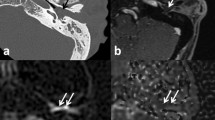Abstract
Diffusion-weighted (DW) MRI has recently increasingly gained popularity in the diagnosis of post-operative cholesteatoma. The aim of this study is to prospectively evaluate the usefulness of echo-planar imaging (EPI) for the diagnosis of residual cholesteatoma. Fifty patients underwent DW-EPI before surgery. Fifteen patients had a scan before their first surgery and 35 patients underwent neuroimaging prior to their second look surgery. In the first preoperative group of 15 patients, DW-EPI confirmed cholesteatoma in all the patients. In the post-operative group DW-EPI identified or excluded cholesteatoma correctly in 29 out of 35 patients. Our study has demonstrated a sensitivity of 83% and specificity of 82% of DW-EPI for the diagnosis of residual cholesteatoma. DW-EPI can be a value imaging modality and may help the surgeon in selecting patients for revision surgery.

Similar content being viewed by others
References
Tierney PA, Pracy P, Blaney SPA, Bowdler DA (1999) An assessment of the value of the preoperative computed tomography scans prior to otoendoscopic second look in intact canal wall mastoid surgery. Clin Otolaryngol 24(4):274–276
Ayache D, Williams MT, Lejeunne D, Corre A (2005) Usefulness of delayed postcontrast magnetic resonance imaging in the detection of residual cholesteatoma after canal wall-up tympanoplasty. Laryngoscope 115(4):607–610
Fitzek C, Mewes T, Fitzek S, Mentzel HJ, Hunsche S, Stoeter P (2002) Diffusion-weighted MRI of cholesteatoma of the petrous bone. J Magn Reson Imaging 15(6):636–641
De Foer B, Vercruysse JP, Pilet B et al (2006) Single-shot, turbo spin-echo, diffusion-weighted imaging versus spin-echo planar, diffusion-weighted imaging in the detection of acquired middle ear cholesteatoma. AJNR 27:1480–1482
Brackmann DE (1993) Tympanoplasty with mastoidectomy: canal wall up procedures. Am J Otol 14:380–382
Shelton C, Sheehy JL (1990) Tympanoplasty: review of 400 staged cases. Laryngoscope 100(7):679–681
Mishiro Y, Sakagami M, Kitahara T (2008) The investigation of the recurrence rate of cholesteatoma using Kaplan–Meier survival analysis. Otol Neurotol 29(6):803–806
Syms MJ, Luxford WM (2003) Management of cholesteatoma: status of the canal wall. Laryngoscope 113(3):443–448
Ayache S, Tramier B, Strunski V (2008) Otoendoscopy in cholesteatoma surgery of the middle ear: what benefits can be expected? Otol Neurotol 29(8):1085–1090
Hamilton JW (2005) Efficacy of the KTP laser in the treatment of middle ear cholesteatoma. Otol Neurotol 26(2):135–139
Wake M, Robinson JM, Witcombe JB et al (1992) Detection of recurrent cholesteatoma by computerized tomography after “closed cavity” mastoid surgery. J Laryngol Otology 106(5):393–395
Kimitsuki T, Suda Y, Kawano H et al (2001) Correlation between MRI findings and second look operation in cholesteatoma surgery. ORL J Otorhinolaryngol Relat Spec 63(5):291–293
Vanden Abeele D, Coen E, Parizel PM (1999) Can MRI replace a second look operation in cholesteatoma surgery? Acta Otolaryngol 119(5):555–561
Brammer R (2003) Basic principles of diffusion-weighted imaging. Eur J Radiol 45(3):169–184
Le Bihan D, Turner R, Douek P, Patronas N (1992) Diffusion MR Imaging: clinical applications. AJR 159:591–599
Jeunen G, Desloovere C, Hermans R, Vandecaveye V (2008) The value of magnetic resonance imaging in the diagnosis of residual or recurrent acquired cholesteatoma after canal wall-up tympanoplasty. Otol Neurotol 29(1):16–18
Venail F, Bonafe A, Poirrier V et al (2008) Comparison of echo-planar diffusion-weighted imaging and delayed postcontrast T1-weighted MR imaging for the detection of residual cholesteatoma. AJNR 29(7):1363–1368
Aikele P, Kittner T, Offergeld C et al (2003) Diffusion-weighted MR Imaging of cholesteatoma in pediatric and adult patients who have undergone middle ear surgery. AJR 181:261–265
Stasolla A, Magliulo G, Parrotto D et al (2004) Detection of postoperative relapsing/residual cholesteatomas with diffusion-weighted echo-planar magnetic resonance imaging. Otol Neurotol 25(6):879–884
Hagmann P, Jonasson L, Maeder P et al (2006) Understanding diffusion MR imaging techniques: from scalar diffusion-weighted imaging to diffusion tensor imaging and beyond. Radiographics 26(Suppl 1):S205–S223 (review)
Vercruysse JP, De Foer B, Pouillon M et al (2006) The value of diffusion-weighted MR imaging in the diagnosis of primary acquired and residual cholesteatoma: a surgical verified study of 100 patients. Eur Radiol 16:1461–1467
Dubrulle F, Souillard R, Chechin D et al (2006) Diffusion-weighted MR imaging sequence in the detection of postoperative recurrent cholesteatoma. Radiology 238:604–610
De Foer B, Vercruysse JP, Bernaerts A et al (2008) Detection of postoperative residual cholesteatoma with non-echo planar diffusion-weighted magnetic resonance imaging. Otol Neurotol 29(4):513–517
Dhepnorrarat RC, Wood B, Rajan GP (2009) Postoperative non-echo planar diffusion-weighted magnetic resonance imaging changes after cholesteatoma surgery: implications for cholesteatoma surgery. Otol Neurotol 30(1):54–58
De Foer B, Vercruysse JP, Bernaerts A et al (2007) The value of single-shot turbo spin-echo diffusion-weighted MR imaging in the detection of middle ear cholesteatoma. Neuroradiology 49(10):841–848
Conflict of interest statement
The authors declare that they have no conflict of interest.
Author information
Authors and Affiliations
Corresponding author
Rights and permissions
About this article
Cite this article
Jindal, M., Doshi, J., Srivastav, M. et al. Diffusion-weighted magnetic resonance imaging in the management of cholesteatoma. Eur Arch Otorhinolaryngol 267, 181–185 (2010). https://doi.org/10.1007/s00405-009-1023-7
Received:
Accepted:
Published:
Issue Date:
DOI: https://doi.org/10.1007/s00405-009-1023-7




